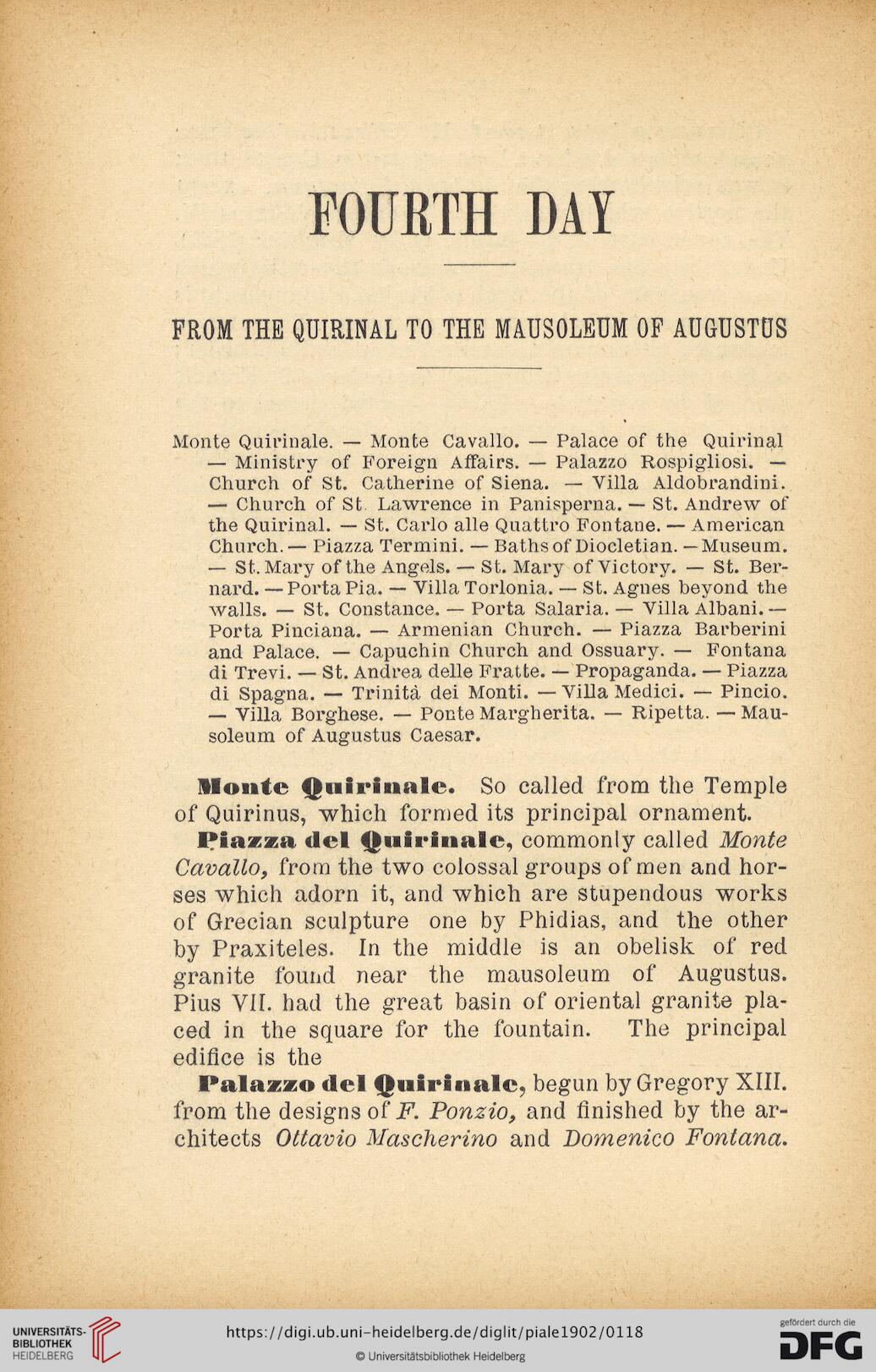FOURTH DAY
FROM THE QUIRINAL TO THE MAUSOLEUM OF AUGUSTUS
Monte Quirinale. — Monte Cavallo. — Palace of the Quirinal
— Ministry of Foreign Affairs. — Palazzo Rospigliosi. —
Church of St. Catherine of Siena. — Villa Aldobrandini.
— Church of St. Lawrence in Panisperna. — St. Andrew of
the Quirinal. — St. Carlo alle Quattro Fontane. — American
Church.— Piazza Termini. — Baths of Diocletian. — Museum.
— St. Mary of the Angels. — St. Mary of Victory. — St. Ber-
nard. — Porta Pia. — Villa Torlonia. — St. Agnes beyond the
walls. — St. Constance. — Porta Salaria. — Villa Albani. —
Porta Pinciana. — Armenian Church. — Piazza Barberini
and Palace. — Capuchin Church and Ossuary. — Fontana
di Trevi. — St. Andrea delle Fratte. — Propaganda. — Piazza
di Spagna. — Trinita dei Monti. — Villa Medici. — Pincio.
— Villa Borghese. — Ponte Margherita. — Ripetta. — Mau-
soleum of Augustus Caesar.
Monte Quirinale. So called from the Temple
of Quirinus, which formed its principal ornament.
Piazza del Quirinale, commonly called Monte
Cavallo, from the two colossal groups of men and hor-
ses which adorn it, and which are stupendous works
of Grecian sculpture one by Phidias, and the other
by Praxiteles. In the middle is an obelisk of red
granite found near the mausoleum of Augustus.
Pius VII. had the great basin of oriental granite pla-
ced in the square for the fountain. The principal
edifice is the
Palazzo del Quirinale, begun by Gregory XIII.
from the designs of F. Ponzio, and finished by the ar-
chitects Ottavio Mascherino and Domenico Fontana.
FROM THE QUIRINAL TO THE MAUSOLEUM OF AUGUSTUS
Monte Quirinale. — Monte Cavallo. — Palace of the Quirinal
— Ministry of Foreign Affairs. — Palazzo Rospigliosi. —
Church of St. Catherine of Siena. — Villa Aldobrandini.
— Church of St. Lawrence in Panisperna. — St. Andrew of
the Quirinal. — St. Carlo alle Quattro Fontane. — American
Church.— Piazza Termini. — Baths of Diocletian. — Museum.
— St. Mary of the Angels. — St. Mary of Victory. — St. Ber-
nard. — Porta Pia. — Villa Torlonia. — St. Agnes beyond the
walls. — St. Constance. — Porta Salaria. — Villa Albani. —
Porta Pinciana. — Armenian Church. — Piazza Barberini
and Palace. — Capuchin Church and Ossuary. — Fontana
di Trevi. — St. Andrea delle Fratte. — Propaganda. — Piazza
di Spagna. — Trinita dei Monti. — Villa Medici. — Pincio.
— Villa Borghese. — Ponte Margherita. — Ripetta. — Mau-
soleum of Augustus Caesar.
Monte Quirinale. So called from the Temple
of Quirinus, which formed its principal ornament.
Piazza del Quirinale, commonly called Monte
Cavallo, from the two colossal groups of men and hor-
ses which adorn it, and which are stupendous works
of Grecian sculpture one by Phidias, and the other
by Praxiteles. In the middle is an obelisk of red
granite found near the mausoleum of Augustus.
Pius VII. had the great basin of oriental granite pla-
ced in the square for the fountain. The principal
edifice is the
Palazzo del Quirinale, begun by Gregory XIII.
from the designs of F. Ponzio, and finished by the ar-
chitects Ottavio Mascherino and Domenico Fontana.




